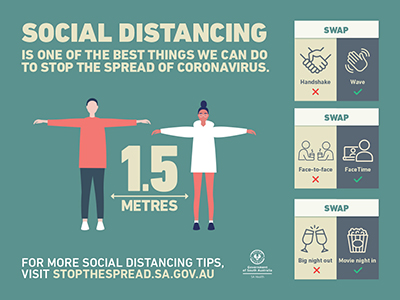We may well be able to eliminate coronavirus, but we’ll probably never eradicate it. Here’s the difference
By Professor of Biostatistics Adrian Esterman
 HEALTH
HEALTHCompared to many other countries around the world, Australia and New Zealand have done an exceptional job controlling COVID-19.
As of 19 May, there were 572 active cases of COVID-19 in Australia. Only 45 were in hospital.
The situation in New Zealand is similar, with 40 active cases, only two of whom are in hospital.
If we continue on this path, could we eliminate COVID-19 from Australia and New Zealand?
Control –> elimination –> eradication
In order to answer this question, we first to need to understand what elimination means in the context of disease, and how it differs from control and eradication.

Disease control is when we see a reduction in disease incidence and prevalence (new cases and current cases) as a result of public health measures. The reduction does not mean to zero cases, but rather to an acceptable level.
Unfortunately, there’s no consensus on what is acceptable. It can differ from disease to disease and from jurisdiction to jurisdiction.
As an example, there were only 81 cases of measles reported in Australia in 2017. Measles is considered under control in Australia.
Conversely, measles is not regarded as controlled in New Zealand, where there was an outbreak in 2019. From 1 January 1 2019 to 21 February 2020, New Zealand recorded 2194 measles cases.
For disease elimination, there must be zero new cases of the disease in a defined geographic area. There is no defined time period this needs to be sustained for – it usually depends on the incubation period of the disease (the time between being exposed to the virus and the onset of symptoms).

For example, the South Australian government is looking for 28 days of no new coronavirus cases (twice the incubation period of COVID-19) before they will consider it eliminated.
Even when a disease has been eliminated, we continue intervention measures such as border controls and surveillance testing to ensure it doesn’t come back.
For example, in Australia, we have successfully eliminated rubella (German measles). But we maintain an immunisation schedule and disease surveillance program.
Finally, disease eradication is when there is zero incidence worldwide of a disease following deliberate efforts to get rid of it. In this scenario, we no longer need intervention measures.
Only two infectious diseases have been declared eradicated by the World Health Organisation – smallpox in 1980 and rinderpest (a disease in cattle caused by the paramyxovirus) in 2011.
Polio is close to eradication with only 539 cases reported worldwide in 2019.
Guinea worm disease is also close with a total of just 19 human cases from January to June 2019 across two African countries.
What stage are we at with COVID-19?

In Australia and New Zealand we currently have COVID-19 under control.
Importantly, in Australia, the effective reproduction number (Reff) is close to zero. Estimates of Reff come from mathematical modelling, which has not been published for New Zealand, but the Reff is likely to be close to zero in New Zealand too.
The Reff is the average number of people each infected person infects. So a Reff of 2 means on average, each person with COVID-19 infects two others.
If the Reff is greater than 1 the epidemic continues; if the Reff is equal to 1 it becomes endemic (that is, it grumbles along on a permanent basis); and if the Reff is lower than 1, the epidemic dies out.
So we could be on the way to elimination.
In both Australia and New Zealand we have found almost all of the imported cases, quarantined them, and undertaken contact tracing. Based on extensive community testing, there also appear to be very few community-acquired cases.
The next step in both countries will be sentinel surveillance, where random testing is carried out in selected groups. Hopefully in time these results will be able to show us COVID-19 has been eliminated.
It’s unlikely COVID-19 will ever be eradicated
To be eradicated, a disease needs to be both preventable and treatable. At the moment, we neither have anything to prevent COVID-19 (such as a vaccine) nor any proven treatments (such as antivirals).
Even if a vaccine does become available, SARS-CoV-2 (the virus that causes COVID-19) easily mutates. So we would be in a situation like we are with influenza, where we need annual vaccinations targeting the circulating strains.
The other factor making COVID-19 very difficult if not impossible to eradicate is the fact many infected people have few or no symptoms, and people could still be infectious even with no symptoms. This makes case detection very difficult.
At least with smallpox, it was easy to see whether someone was infected, as their body was covered in pustules (fluid-containing swellings).
So while we may well be on the path to elimination in Australia and New Zealand, eradication is a different ball game.
This article is republished from The Conversation under a Creative Commons license. Read the original article.
Other Stories
- Excess coffee consumption a culprit for poor health
- We may well be able to eliminate coronavirus, but we’ll probably never eradicate it. Here’s the difference
- $10m fund helping students hardest hit by economic downturn
- Bittersweet celebration of nurses and midwives, 200 years after Florence Nightingale’s birth
- From the Vice Chancellor
- Achievements and Announcements
- Hawke’s legacy continues to grow as new materials added to archival collection
- Binge drinkers beware, Drunkorexia is calling
- Team effort creates ‘red dirt’ Anangu education space in the Adelaide Hills
- ‘Like looking for a needle in a haystack’: UniSA joins global hunt to find key molecule to block COVID-19
- Video: Hop aboard UniSA’s 737 flight simulator
- Simple teaching simulations prove big asset for UniSA and beyond
- Adjunct Professor John Wardle receives highest national architecture accolade
- The latest book from UniSA researchers
- In Pictures: Teal raises awareness for ovarian cancer




